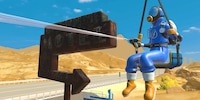
Background information
Powerwash Simulator and many more: why we like boring busywork in our games
by Rainer Etzweiler

Appointments, e-mails, deadlines: when was the last time you took a break? If you're often overloaded, here are a few tips.
Many people answer emails, do some quick research or update themselves on Instagram over lunch. A few moments later, the lunchtime half-hour has already passed, and another four hours and an avalanche of work awaits them. This is actually a fairly common occurrence. In fact, the (too) heavy workload sometimes prevents people from leaving their posts for even half an hour or taking the necessary breaks from time to time.
Occupational psychologist Dr Johannes Wendsche from the German Bundesanstalt für Arbeitsschutz und Arbeitsmedizin is carrying out full-time research into breaks and confirms, "One in three or four members of staff often don't take a break. 85 per cent of them say that high emotional demands, pressure of deadlines and too high a work density are the cause."
In Switzerland too, stress and high work pressure are encroaching on rest and leisure time. So writes the umbrella organisation for working people, Travail.Suisse, in its Working Conditions Barometer 2022 report.
Most people have lost the habit of pressing the "pause" button. Especially as social networking applications, messaging services and email programs compete for your attention [every four minutes (link in German)](https://nextworkinnovation.com/studie-arbeitsunterbrechungen/#:~:text=Study%20Work interruptions%20%2D%20Next%20Work%20Innovation&text=Every%20four%20minutes%20become%20knowledge workers,days%20by%20months%20of unproductive work%20) and interrupt your work. I discussed the importance of the break, the role of the smartphone in this context and how to take a good break with Mr Wendsche.
In theory, in Switzerland, you can work for seven hours straight before taking a compulsory half-hour break. Yet the average adult attention span is only around 90 minutes. For children, this figure in minutes corresponds to twice their age in years.
The trend is downwards, because according to a study by the Max Plank Institute (link in German), attention is increasingly reduced by notifications and the flood of information on social networks.
Breaks are essential for your well-being at work. As well as the rest function, breaks have a social function: "By allowing people to meet up during the break, it becomes a central element for the culture in the company and for the atmosphere at work," says Wendsche. He adds that breaks help to structure the day, as they tangibly separate tasks.
Finally, the break has a motivational and learning function. Dividing work into shorter units has a more energising effect and encourages people to put in more effort during periods of actual work, Wendsche argues through his own studies.
Finally, breaks have a motivational and learning function.
Pauses are a moment our brains need to assimilate new knowledge, which is why they are necessary both at school and in the office.
If we wait too long, the negative consequences of the workload accumulate and can become a chronic problem. "You become more exhausted, you suffer from psychosomatic disorders, concentration problems, but also musculoskeletal pain that accumulates," explains Mr Wendsche.
In fact, a Korean study (link in English) confirms that musculoskeletal disorders, such as neck, back or hand pain, account for 70 per cent of all work-related illnesses (also in Europe). Regular breaks from the daily grind would help to reduce them.
Over time, exhaustion can set in. We then make more mistakes and the risk of accidents at work increases. What's more, regular breaks keep performance at a stable level. "Members of staff who take enough breaks are more creative and more effective, their performance varies less and they work more regularly," adds the expert.
At the end of the day, you'll have more fun at work if you respect your break times: "Where team breaks are taken, staff resign less often."What's more, the beneficial effect will be felt in terms of sick leave and absences. "With enough breaks, age-related absences can be significantly reduced, even catching up with the absence rate of younger staff."
The break culture in Switzerland still leaves something to be desired. If you work for seven hours straight, you quickly become exhausted and your performance is no longer up to the standard expected of you. Letting your mind wander from time to time or taking short breaks is often frowned upon.
To cope with the pressure of work, staff often take masked breaks: "They fetch equipment, make unnecessary journeys, read online newspapers or social network feeds. These masked breaks account for between 5 and 15 per cent of working time, but they're less restful because they're associated with the fear of getting caught," Wendsche sheds light on the situation.
As well as a longer break in the middle of the day, the expert also advocates short breaks of five minutes per hour. This is because symptoms of fatigue are reduced during the break, but this occurs in a negative exponential way. In other words, "at first you eliminate a lot of fatigue and then less and less."
The whole company benefits from the short break system. During his research, Wendsche learned that with short breaks, working time was reduced by around ten minutes a day, but staff were more productive and the quality of work also improved by nine per cent.
Research into breaks is already over 100 years old. It's not just the smartphone that has changed the world of work and breaks. Intellectual work has also largely replaced physical work. The mental load is different from the physical load," says Wendsche. Signs of fatigue are more often absent, even if physiological indicators seem normal." In other words, these days, there is a greater risk of skipping breaks and overworking.. Moreover, we often spend our breaks, masked or conscious, in front of our smartphone. This is not a bad thing in itself, as social media in particular meet the need for social connection, Wendsche continues. However, "the break most people take with their eyes glued to their smartphones is not restful, as it involves the same parts of the brain as work itself."
Taking a break is important. Even if you can't persuade your management to adopt a system of short breaks, you need to take time out for yourself from time to time to breathe and recover your strength. Here are Dr Wendsche's tips for a restorative break:
The best way to approach your break depends on the nature of your activity. It's best if the break contrasts with the workload: if you're moving around a lot, you should sit down. If you work alone, you should take a break with your team. People who spend a lot of time sitting down should stand up. People who think a lot should let their minds wander. This prevents monotony at work, you give yourself new impulses and you return to your workstation with a fresh mind.
Between us, who manages to relax at work while the colleagues next door are typing away on their keyboards and the boss is holding a meeting in the conference room? Take advantage of your break to get a change of scenery. The further away you are from your workplace, the better you can switch off. At the same time, it reduces the risk of interruptions. The break is for recuperating, and it belongs to you alone. You can leave your emails, mobile phone and diary at your workplace for those few precious minutes.
In many jobs, the workload is monotonous and more mental than physical. Sitting for long periods looking at the screen is not only bad for the eyes, it's also a creeping strain on the whole body. Take advantage of your break to do some gentle exercise, a short walk or a few stretching exercises. Your joints, tendons and muscles will thank you, and so will your head. For example, a study (in English) on the effects of three minutes' physical activity during office work shows that even brief physical activity reduces stress, increases enjoyment of work, boosts employees' health awareness and enables social interaction in the workplace.
The added value of breaks spent in greenery is even greater. It has been proven that a walk in nature lowers stress hormones and blood pressure. The break room at work should also be designed accordingly. All it takes is a balcony, windows, green elements or forest wallpaper to promote these relaxing effects.
It's no coincidence that most people whip out their smartphones during their breaks. It connects us to other people and is an ideal distraction after the frenzy of work. Since smartphones and social media serve a certain purpose (and have become indispensable to everyday life anyway), there's nothing totally against them either.
A German study even comes to this conclusion. Surfing the Net at work increases creativity and promotes concentration. As always, it's the dose that makes the poison. While smartphone use during short breaks increases engagement at work, a study (in English) shows that long, intensive browsing sessions have a negative effect on engagement at work.
In other words, you shouldn't spend your entire break in front of your mobile phone, as responding to private messages can also be cognitively demanding. Instead, the expert recommends limiting screen time and focusing on other needs during the break. For example, looking away from the screen and letting your thoughts wander freely often provides the most restful break time.
Headline photo: shutterstock
I'm a sucker for flowery turns of phrase and allegorical language. Clever metaphors are my Kryptonite – even if, sometimes, it's better to just get to the point. Everything I write is edited by my cat, which I reckon is more «pet humanisation» than metaphor. When I'm not at my desk, I enjoy going hiking, taking part in fireside jamming sessions, dragging my exhausted body out to do some sport and hitting the occasional party.
Interesting facts about products, behind-the-scenes looks at manufacturers and deep-dives on interesting people.
Show all
Background information
by Rainer Etzweiler

Background information
by Daniela Schuster

Background information
by Katherine Martin